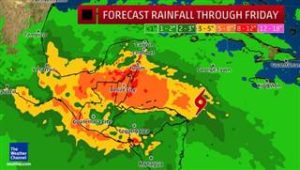Tropical Storm Earl is expected to be a hurricane by the time it hits Belize or extreme southern Mexico on Wednesday, forecasters said.
The center of Earl was about 315 miles east-southeast of Belize City at 5 a.m. ET, according to the National Hurricane Center. It was moving west at a brisk 14 mph with top sustained winds of 60 mph.
The storm has already been blamed for deaths in the Dominican Republic.
Hurricane warnings were in force Wednesday for an area covering Belize City and Puerto Costa Maya in Mexico’s Yucatan Peninsula south to the Guatemala border. As much as 16 inches of rain could fall on Belize and the peninsula as Earl — the Atlantic basin’s first named storm since late June — approaches land sometime late Wednesday or early Thursday.
The National Hurricane Center warned of a damaging storm surge that could raise water levels as much as 5 feet above normal tide levels along the coast of Belize and the eastern Yucatan Peninsula.
Honduras and Guatemala are also set to get slammed with 8 to 12 inches of rain, along with high winds and flooding.
“There is going to be very strong wind … and it’ll move fairly fast, but there will still be enough rain that I think flooding will be a considerable issue,” said Ari Sarsalari, a meteorologist for The Weather Channel.
The storm threat comes after Earl — as a weaker tropical wave — pummeled the Dominican Republic on Sunday, knocking down power lines and starting a fire that killed six passengers on a bus filled with people returning from the beach, The Weather Channel reported.
The United States isn’t expected to take a direct hit, although the U.S. Gulf Coast could experience some significant rip currents, Sarsalari said.
This is the seventh time the name Earl has been used for an Atlantic storm. It made its debut among Atlantic storm systems in 1980 and was then used again in 1986, 1992, 1998, 2004 and 2010.
The last Earl grew into a hurricane that passed well off North Carolina’s Outer Banks, but it still caused flooding across the state and battered a big swath of the East Coast with waves and high winds.
Typically, Atlantic hurricane and tropical storm name lists repeat every six years. But if a storm turns deadly or destructive, the World Meteorological Organization committee votes to retire its name from future lists.
Read more here.


